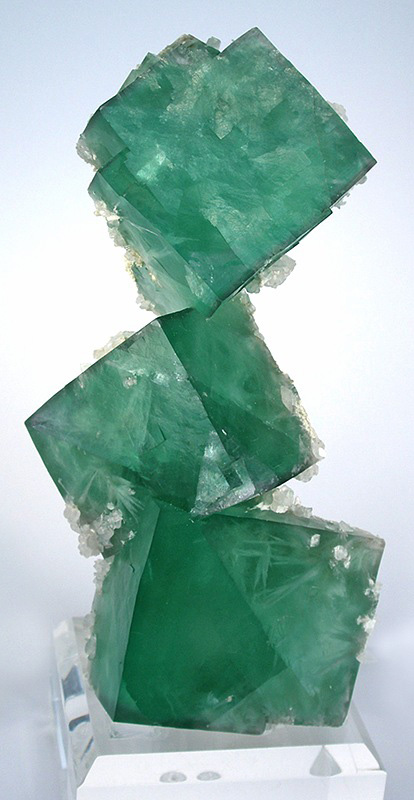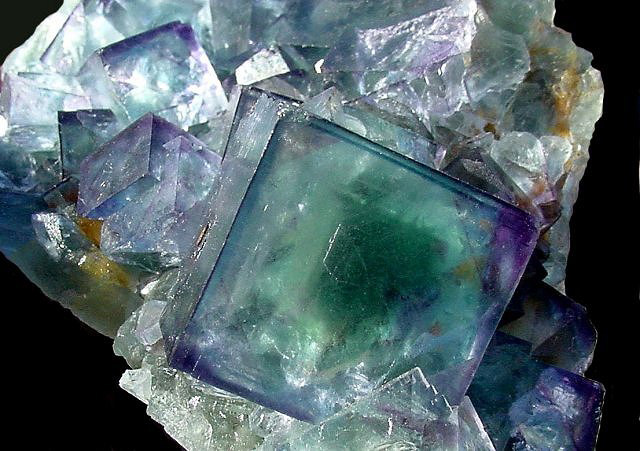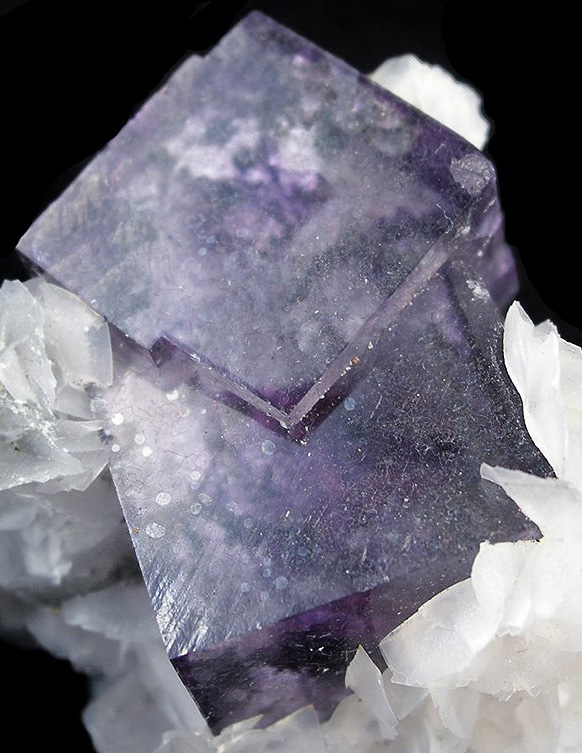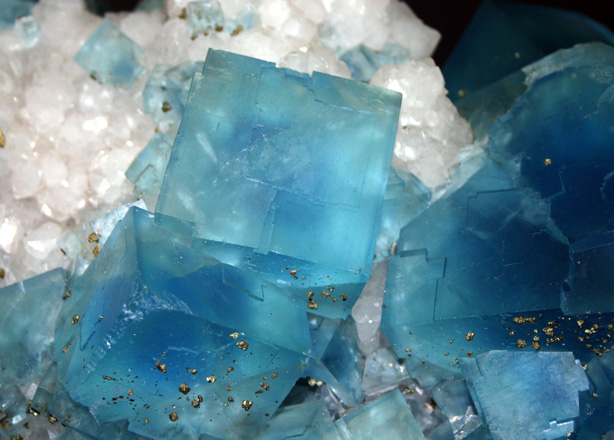Fluorite
Fluorite is a very widely occuring mineral with the chemical formula CaF2 - calcium fluoride. It is an isometric mineral, meaning that the basic "unit" shape or building block is a cube, hence the cubic shape of fluorite crystals. However, fluorites can also form octahedral crystals and other shapes are also possible [1] including dodecahedrons and other "modified cube" shapes. [2]

Fluorite (green) with white aragonite needles inside.
From Far-Eastern Russia; total length 17.1cm.
Photo by Rob Lavinsky, iRocks.com - image lic. under CC-BY-SA-3.0
As can be seen from the photos, fluorite can occur in a wide range of stunning colors. These include blue, green, yellow, purple, violet, pink, transparent and even bicolor or multicolor - with more than one color in the same stone.
Fluorite is also well known for its ability to occur as intergrown cubes, which as can be seen can make some spectacular forms. Intergrown octahedrons of fluorite are also possible and not uncommon. As can be imagined, this combination of unusual forms and rich coloration means that fluorite is very popular with mineral collectors. Another mineral that can form intergrown cubes is pyrite.
Despite its relative softness (4 on the Mohs scale), Fluorite is sometimes cut into a gemstone and can be seen in the well known "fancy cut" shapes, including step cut, round cut, cushion cut and cabochon (domed) - although these are unlikely to be set into jewelry owing to their delicate nature. [3]
The word fluorescence was derived from fluorite and is defined as the "emission of light by a substance that has absorbed light or other electromagnetic radiation of a different wavelength." [4] Many fluorites will "glow" under UV light - typically this glow is blue but can also be many other colors depending on the presence of ions of other metals. The blue fluorescence has been attributed to europium ions; yttrium has been named as the cause of yellow fluorescence, with the source of other colors still to be ascertained. [2]
Another fascinating property of fluorite, which only occurs rarely, is thermoluminescence. This is the property of glowing when heated - and it happens only once in any given specimen; once activated, it will not happen again. One fluorite variety, chlorophane, will even glow after being held in a warm hand, although the glow can only be seen in darkness and not in daylight. [2]
In addition to being collected as a mineral specimen, fluorite also has use in industry: It is used as a flux, to lower the melting point of mixtures in steel production, and in the manufacture of enamels. It also has an interesting use in the manufacture of special high quality lenses for cameras, microscopes and telescopes: Fluorite has a low level of dispersion, and so displays lower chromatic aberration than glass. It also has a higher transparency to UV light and has use in UV imaging. Some optical instrument manufacturers use synthetic fluorite materials for lens manufacture. [5]
Fluorite Images

Fluorite

Fluorite (purple) with calcite (white), from Hunan Province, China. Size - 4.3cm long.
Photo by Rob Lavinsky, iRocks.com - image lic. under CC-BY-SA-3.0

Fluorite (blue) with flecks of gold pyrite. At the Milan Museum of Natural History.
Photo by Giovanni Dall'Orto - released under CCA-SA-2.5 Italy license
Fluorite - Sources Referenced:
[1] http://en.wikipedia.org/wiki/Fluorite
[2] http://www.galleries.com/minerals/halides/fluorite/fluorite.htm
[3] http://www.realgems.org/list_of_gemstones/fluorite.html
[4] http://en.wikipedia.org/wiki/Fluorescence
[5] http://en.wikipedia.org/wiki/Fluorite
Back to the Gemstones List home page - over 160 gemstones explored!
Please feel free to link to this page - copy / paste the text below: (click to select)
Privacy Policy | Cookie Policy | GDPR | About This Site / Terms

© gemstoneslist.com


